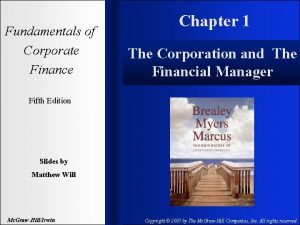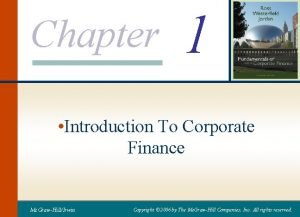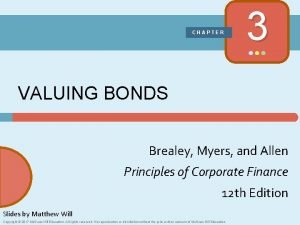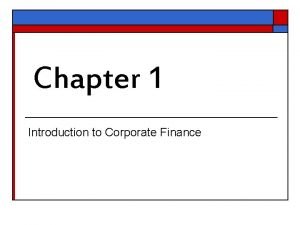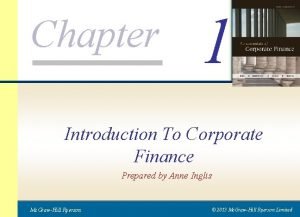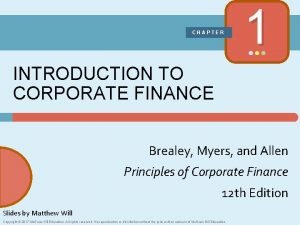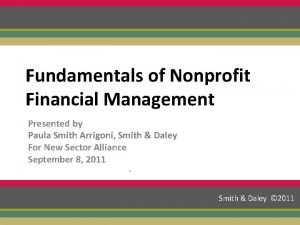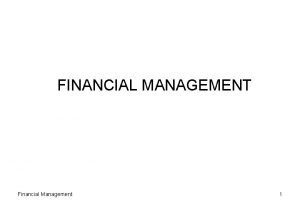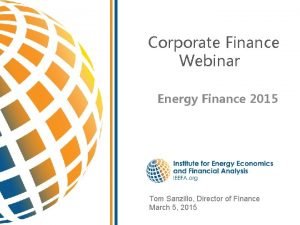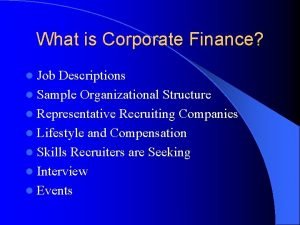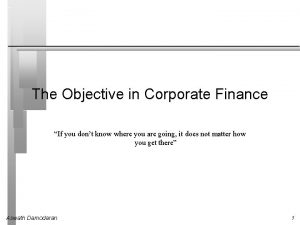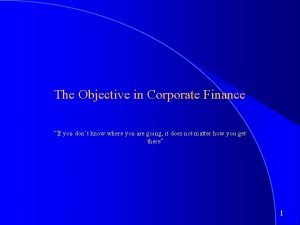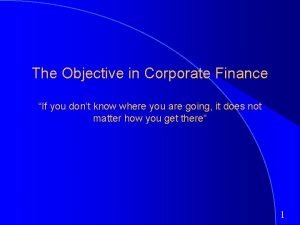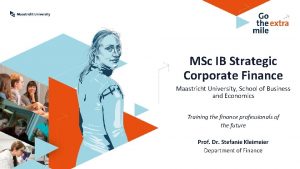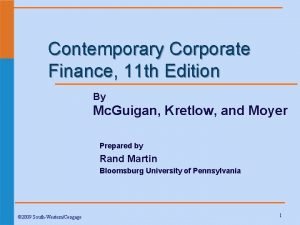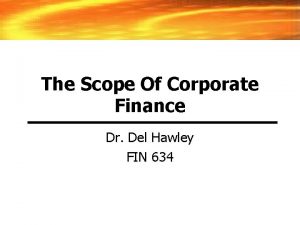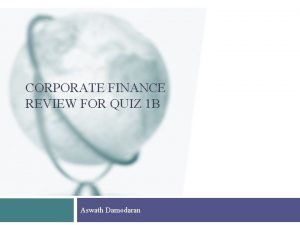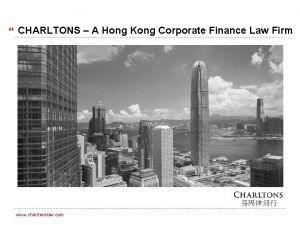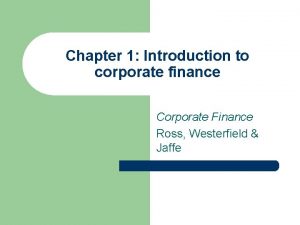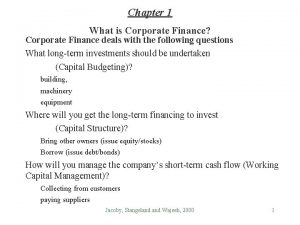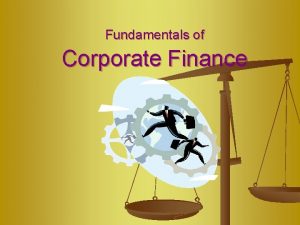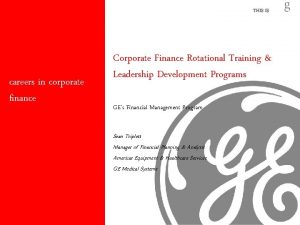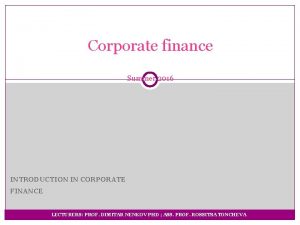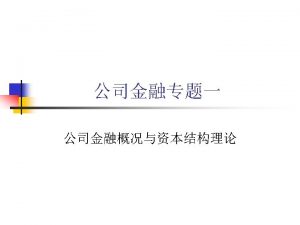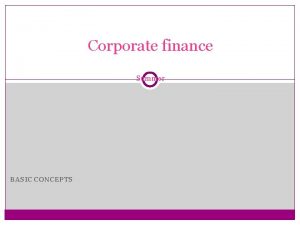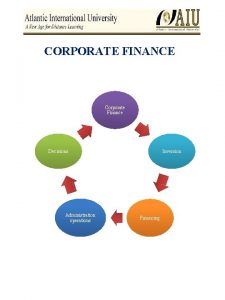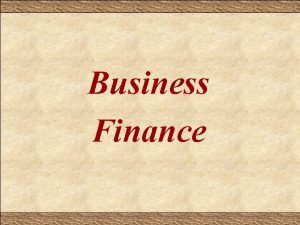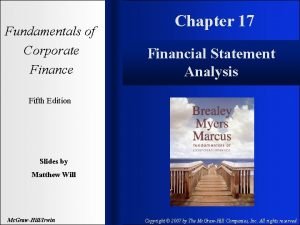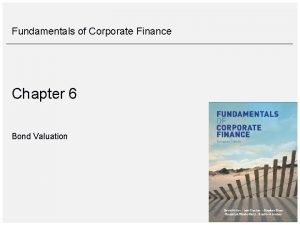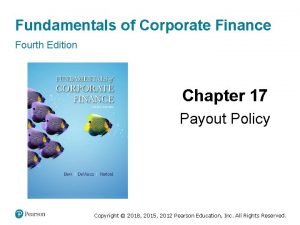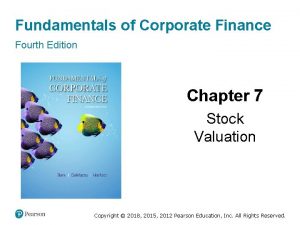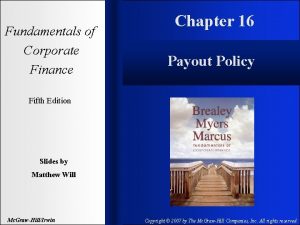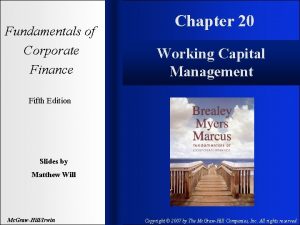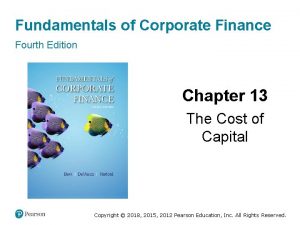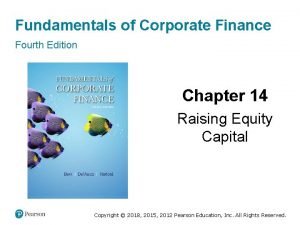16 1 Fundamentals of Corporate Finance Chapter 16




























- Slides: 28

16 - 1 Fundamentals of Corporate Finance Chapter 16 Debt Policy Sixth Edition Richard A. Brealey Stewart C. Myers Alan J. Marcus Slides by Matthew Will Mc. Graw Hill/Irwin Copyright ©Copyright 2009 by The Mc. Graw-Hill Companies, Inc. All rights reserved © 2009 by The Mc. Graw-Hill Companies, Inc. All rights reserved

16 - 2 Topics Covered w Debt and Value in a Tax Free Economy w Capital Structure and Corporate Taxes w Cost of Financial Distress w Explaining Financial Choices w Bankruptcy Procedures Mc. Graw Hill/Irwin Copyright © 2009 by The Mc. Graw-Hill Companies, Inc. All rights reserved

16 - 3 Value and Capital Structure Assets Value of cash flows from firm’s real assets and operations Value of Firm Mc. Graw Hill/Irwin Liabilities and Stockholder’s Equity Market value of debt Market value of equity Value of Firm Copyright © 2009 by The Mc. Graw-Hill Companies, Inc. All rights reserved

16 - 4 Average Book Debt Ratios Mc. Graw Hill/Irwin Copyright © 2009 by The Mc. Graw-Hill Companies, Inc. All rights reserved

16 - 5 M&M (Debt Policy Doesn’t Matter) w Modigliani & Miller è When there are no taxes and capital markets function well, the market value of a company does not depend on its capital structure. In other words, financial managers cannot increase value by changing the mix securities used to finance the company. Mc. Graw Hill/Irwin Copyright © 2009 by The Mc. Graw-Hill Companies, Inc. All rights reserved

16 - 6 M&M (Debt Policy Doesn’t Matter) Assumptions w By issuing 1 security rather than 2, company diminishes investor choice. This does not reduce value if: è Investors do not need choice, OR è There are sufficient alternative securities w Capital structure does not affect cash flows e. g. . . è No taxes è No bankruptcy costs è No effect on management incentives Mc. Graw Hill/Irwin Copyright © 2009 by The Mc. Graw-Hill Companies, Inc. All rights reserved

16 - 7 M&M (Debt Policy Doesn’t Matter) Example - River Cruises - All Equity Financed Mc. Graw Hill/Irwin Copyright © 2009 by The Mc. Graw-Hill Companies, Inc. All rights reserved

16 - 8 M&M (Debt Policy Doesn’t Matter) Example cont. 50% debt Mc. Graw Hill/Irwin Copyright © 2009 by The Mc. Graw-Hill Companies, Inc. All rights reserved

16 - 9 M&M (Debt Policy Doesn’t Matter) Borrowing increases EPS for River Cruises Mc. Graw Hill/Irwin Copyright © 2009 by The Mc. Graw-Hill Companies, Inc. All rights reserved

16 - 10 M&M (Debt Policy Doesn’t Matter) Example - River Cruises - All Equity Financed - Debt replicated by investors Mc. Graw Hill/Irwin Copyright © 2009 by The Mc. Graw-Hill Companies, Inc. All rights reserved

16 - 11 M&M (Debt Policy Doesn’t Matter) Example - River Cruises – Firm debt at 50% - Investor can unwrap debt Mc. Graw Hill/Irwin Copyright © 2009 by The Mc. Graw-Hill Companies, Inc. All rights reserved

16 - 12 River Cruise’s “Value Pie” Mc. Graw Hill/Irwin Copyright © 2009 by The Mc. Graw-Hill Companies, Inc. All rights reserved

16 - 13 C. S. & Corporate Taxes Operating Risk (business risk) – Risk in the firm’s operating income. Financial Risk - Risk to shareholders resulting from the use of debt. Financial Leverage - Increase in the variability of shareholder returns that comes from the use of debt. Interest Tax Shield- Tax savings resulting from deductibility of interest payments. Mc. Graw Hill/Irwin Copyright © 2009 by The Mc. Graw-Hill Companies, Inc. All rights reserved

16 - 14 Mc. Graw Hill/Irwin Cost of Capital Copyright © 2009 by The Mc. Graw-Hill Companies, Inc. All rights reserved

16 - 15 MM’s Proposition II (w/fixed interest rate) r r. E r. A r. D D V Mc. Graw Hill/Irwin Copyright © 2009 by The Mc. Graw-Hill Companies, Inc. All rights reserved

16 - 16 MM’s Proposition II (w/risky debt) r r. E r. A r. D Risk free debt Risky debt Includes Bankruptcy Risk Mc. Graw Hill/Irwin D V Copyright © 2009 by The Mc. Graw-Hill Companies, Inc. All rights reserved

16 - 17 Weighted Average Cost of Capital r r. E WACC with no bankruptcy risk WACC r. D D V Mc. Graw Hill/Irwin Copyright © 2009 by The Mc. Graw-Hill Companies, Inc. All rights reserved

16 - 18 C. S. & Corporate Taxes River Cruise DOES create value in a corporate tax environment by using debt financing. This is done by maximizing the cash flows to both equity and bondholders. Mc. Graw Hill/Irwin Copyright © 2009 by The Mc. Graw-Hill Companies, Inc. All rights reserved

16 - 19 C. S. & Corporate Taxes River Cruise DOES create value in a corporate tax environment by using debt financing. This is done by maximizing the cash flows to both equity and bondholders. Mc. Graw Hill/Irwin Copyright © 2009 by The Mc. Graw-Hill Companies, Inc. All rights reserved

16 - 20 C. S. & Corporate Taxes Example - You own all the equity of Space Babies Diaper Co. The company has no debt. The company’s annual cash flow is $10, 000, before interest and taxes. The corporate tax rate is 35%. You have the option to exchange part of your equity position for 6% bonds with a face value of $50, 000. Should you do this and why? Mc. Graw Hill/Irwin Copyright © 2009 by The Mc. Graw-Hill Companies, Inc. All rights reserved

16 - 21 C. S. & Corporate Taxes Example - You own all the equity of Space Babies Diaper Co. The company has no debt. The company’s annual cash flow is $10, 000, before interest and taxes. The corporate tax rate is 35%. You have the option to exchange part of your equity position for 6% bonds with a face value of $50, 000. Should you do this and why? Mc. Graw Hill/Irwin Copyright © 2009 by The Mc. Graw-Hill Companies, Inc. All rights reserved

16 - 22 C. S. & Corporate Taxes Example - You own all the equity of Space Babies Diaper Co. The company has no debt. The company’s annual cash flow is $10, 000, before interest and taxes. The corporate tax rate is 35%. You have the option to exchange part of your equity position for 6% bonds with a face value of $50, 000. Should you do this and why? Total Cash Flow All Equity = 6, 500 *1/2 Debt = 7, 550 (4, 550 + 3, 000) Mc. Graw Hill/Irwin Copyright © 2009 by The Mc. Graw-Hill Companies, Inc. All rights reserved

16 - 23 Capital Structure PV of Tax Shield = (assume perpetuity) D x r. D x Tc r. D = D x Tc Example: Tax benefit = 50, 000 x (. 06) x (. 35) = $1, 050 PV of 1, 050 perpetuity = 1, 050 /. 06 = $17, 500 PV Tax Shield = D x Tc = 50, 000 x. 35 = $17, 500 Mc. Graw Hill/Irwin Copyright © 2009 by The Mc. Graw-Hill Companies, Inc. All rights reserved

16 - 24 Financial Distress Costs of Financial Distress - Costs arising from bankruptcy or distorted business decisions before bankruptcy. Market Value = Mc. Graw Hill/Irwin Value if all Equity Financed + PV Tax Shield - PV Costs of Financial Distress Copyright © 2009 by The Mc. Graw-Hill Companies, Inc. All rights reserved

16 - 25 Financial Distress Market Value of The Firm Maximum value of firm PV costs of financial distress PV of interest tax shields Value of levered firm Value of all equity financed firm Optimal amount of debt Debt Mc. Graw Hill/Irwin Copyright © 2009 by The Mc. Graw-Hill Companies, Inc. All rights reserved

16 - 26 Financing Games The First Game: Bet the Bank’s Money The Second Game: Don’t Bet Your Own Money These games demonstrate an inherent conflict between shareholders and bondholders. Mc. Graw Hill/Irwin Copyright © 2009 by The Mc. Graw-Hill Companies, Inc. All rights reserved

16 - 27 Financial Choices Trade-off Theory - Theory that capital structure is based on a trade-off between tax savings and distress costs of debt. Pecking Order Theory - Theory stating that firms prefer to issue debt rather than equity if internal finance is insufficient. Financial Slack Mc. Graw Hill/Irwin Copyright © 2009 by The Mc. Graw-Hill Companies, Inc. All rights reserved

16 - 28 Web Resources http: //finance. yahoo. com/ www. bankruptcydata. com www. abiworld. org www. bankrupt. com www. turnaround. org Mc. Graw Hill/Irwin Copyright © 2009 by The Mc. Graw-Hill Companies, Inc. All rights reserved
 Fundamentals of corporate finance chapter 6 solutions
Fundamentals of corporate finance chapter 6 solutions Fundamentals of corporate finance, chapter 1
Fundamentals of corporate finance, chapter 1 Fundamentals of corporate finance, chapter 1
Fundamentals of corporate finance, chapter 1 Fundamentals of corporate finance, third canadian edition
Fundamentals of corporate finance, third canadian edition Fundamentals of corporate finance canadian edition
Fundamentals of corporate finance canadian edition Fundamentals of corporate finance fifth edition
Fundamentals of corporate finance fifth edition Corporate finance 6th edition
Corporate finance 6th edition Objective of corporate finance
Objective of corporate finance Chapter 1 introduction to corporate finance
Chapter 1 introduction to corporate finance Principles of corporate finance chapter 3 solutions
Principles of corporate finance chapter 3 solutions Chapter 1 introduction to corporate finance
Chapter 1 introduction to corporate finance Chapter 1 introduction to corporate finance
Chapter 1 introduction to corporate finance Chapter 1 introduction to corporate finance
Chapter 1 introduction to corporate finance Finance fundamentals for nonprofits
Finance fundamentals for nonprofits Real estate finance fundamentals
Real estate finance fundamentals Modern finance theory
Modern finance theory Corporate finance webinar
Corporate finance webinar Corporate finance vs investment banking
Corporate finance vs investment banking Corporate finance job scope
Corporate finance job scope Objective of corporate finance
Objective of corporate finance Objective of corporate finance
Objective of corporate finance Objective of corporate finance
Objective of corporate finance Maastricht university ib
Maastricht university ib Contemporary corporate finance
Contemporary corporate finance Scope of corporate finance
Scope of corporate finance Objective of corporate finance
Objective of corporate finance Bottom up beta formula
Bottom up beta formula Charlton law firm
Charlton law firm Corporate finance tenth edition
Corporate finance tenth edition


